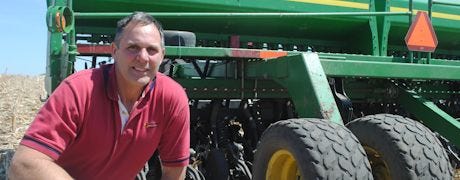
Over the last three years, Jeff Steffen, who farms near the Cedar County hamlet of Constance, has planted soybeans before corn. "I've been planting about 75% of my soybeans first before starting on corn," Steffen says.
Steffen puts fungicide on his soybeans to prevent disease and he feels that soybeans in his region are more flexible and will catch up and eventually turn into a more even stand, even if they don't all come up that way.
Research provided through the Nebraska Soybean Management Field Days plots over the past few years has focused on the yield benefits of early planting and narrow rows. Steffen has seen yield benefits from his early planted soybeans.

BEANS FIRST: For the past three years, Jeff Steffen has planted soybeans before corn to potentially capture better yields and to leave a greater window for planting cover crops in the fall.
Steffen's farm is truly diversified. "Testing new crops and varieties is fun," Steffen says. He enjoys researching new practices and crops himself to test if they will work on his farm. In addition to corn and soybeans, he grows 100 acres of forage peas on contract for cover crop seed. As a member of the Nebraska Crop Improvement Association, he also raises certified oats for seed. Steffen has developed a small oat variety test plot near his farm to study growth and yield of various oat varieties under his management system.
Because of favorable weather, this year he has been custom drilling peas, oats and alfalfa since March. He planted his own forage peas in late March, and says that he will harvest them about the same time in July as he harvests his oats crop.
~~~PAGE_BREAK_HERE~~~
The Steffen farm consists of good bottom land mixed with a few rolling hills. Soil moisture there is adequate in his no-till fields, but he says that he has been surprised at how dry the topsoil is. He has been drilling soybeans at one and a half to two inches depth, to make sure the seed contacts moisture. With his drill, Steffen says that the soil covering the seed is light, so there should be no germination problems. He is drilling his soybeans at a population of around 140,000 seeds per acre, with a harvest population goal of about 100,000.
Residue can cause issues in no-till fields, especially for soybeans following good corn yields. Last season, the winter was quite dry, so residue did not break down like usual, making corn residue more of a concern. This winter was more normal, Steffen says. Residue was broken down by cattle grazing stalks and by the elements and moisture through the winter, so there haven't been the same residue issues.
With his early planted soybeans, Steffen can recall years when soybeans beat the corn out of the ground. He was planting very early maturity soybeans, rated at 1.7, at the end of this week. He hopes to be able to harvest these soybeans and plant cover crops into the stubble early this fall. Although he wishes soil moisture was a bit higher, he was taking advantage of good planting weather this week to continue drilling soybeans before starting on corn.
You can read more about planting season this spring by following new reports next week on Nebraska Farmer online.
About the Author(s)
You May Also Like






